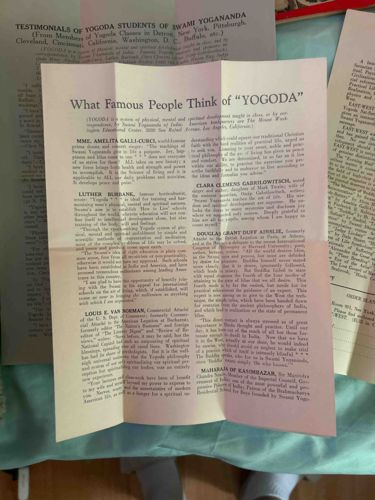
Testimonial Pamphlet: What Famous People Think of 'YOGODA' (circa 1926)
The item is a folded pamphlet or leaflet, likely printed on off-white or cream-colored paper, which has yellowed with age, indicative of its estimated vintage. Its dimensions appear to be standard letter-sized paper when unfolded, approximately 8.5 x 11 inches, folded into thirds. The paper exhibits multiple creases from its folded state, particularly two prominent vertical folds that divide the central panel into three sections. The ink used for printing is black, and the text is predominantly sans-serif for titles and serif for body paragraphs, suggesting a formal and clear presentation. The overall condition shows signs of significant wear, including visible creases, minor wrinkles, and possible discoloration due to exposure and handling over time. There are no obvious tears or major rips, but the paper's edges appear slightly worn. No specific manufacturing details like watermarks or printer's marks are discernible from the image. The content, as indicated by the title "What Famous People Think of 'YOGODA'" and the additional context of "YOGODA 1926 original," strongly suggests that this document dates back to around 1926. This places it within the early 20th century, reflecting the printing and design standards of that period. The document features testimonials from various individuals, including prominent figures such as 'Mme. Amelita Galli-Curci' (a renowned opera singer), 'Luther Burbank' (a famous botanist), 'Maharajah of Kasimbazar,' and 'Louis E. Van Norman' (a diplomat or public figure), all attesting to their positive views on "YOGODA," likely referring to the teachings or organization founded by Swami Yogananda. The clarity of the print and the organized layout suggest a professional production for its time, likely intended for public dissemination as promotional or informational material. Its historical value is significant, providing insight into the reception and early endorsement of Eastern spiritual practices in the Western world during the 1920s.
AI-Generated Appraisal Disclaimer
Estimated Value
$300-500
Basic Information
Category
Historical Document / Ephemera
Appraised On
November 28, 2025
Estimated Value
$300-500
Additional Details Provided By Owner
User Provided Information
What famous people think of YOGODA 1926 original
Item Description
The item is a folded pamphlet or leaflet, likely printed on off-white or cream-colored paper, which has yellowed with age, indicative of its estimated vintage. Its dimensions appear to be standard letter-sized paper when unfolded, approximately 8.5 x 11 inches, folded into thirds. The paper exhibits multiple creases from its folded state, particularly two prominent vertical folds that divide the central panel into three sections. The ink used for printing is black, and the text is predominantly sans-serif for titles and serif for body paragraphs, suggesting a formal and clear presentation. The overall condition shows signs of significant wear, including visible creases, minor wrinkles, and possible discoloration due to exposure and handling over time. There are no obvious tears or major rips, but the paper's edges appear slightly worn. No specific manufacturing details like watermarks or printer's marks are discernible from the image. The content, as indicated by the title "What Famous People Think of 'YOGODA'" and the additional context of "YOGODA 1926 original," strongly suggests that this document dates back to around 1926. This places it within the early 20th century, reflecting the printing and design standards of that period. The document features testimonials from various individuals, including prominent figures such as 'Mme. Amelita Galli-Curci' (a renowned opera singer), 'Luther Burbank' (a famous botanist), 'Maharajah of Kasimbazar,' and 'Louis E. Van Norman' (a diplomat or public figure), all attesting to their positive views on "YOGODA," likely referring to the teachings or organization founded by Swami Yogananda. The clarity of the print and the organized layout suggest a professional production for its time, likely intended for public dissemination as promotional or informational material. Its historical value is significant, providing insight into the reception and early endorsement of Eastern spiritual practices in the Western world during the 1920s.
Get Your Items Appraised
Instant estimates of your treasures with AI-powered instant appraisals